Binary Program Vulnerability Mining Based on Neural Network
2024-03-13ZhenhuiLiShuangpingXingLinYuHuipingLiFanZhouGuangqiangYinXikaiTangandZhiguoWang
Zhenhui Li ,Shuangping Xing ,Lin Yu ,Huiping Li ,Fan Zhou ,Guangqiang Yin ,Xikai Tang and Zhiguo Wang,⋆
1School of Information and Software Engineering,University of Electronic Science and Technology of China,Chengdu,611731,China
2School of Electrical and Computer Engineering,University of Waterloo,Waterloo,N2L 3G1,Canada
ABSTRACT Software security analysts typically only have access to the executable program and cannot directly access the source code of the program.This poses significant challenges to security analysis.While it is crucial to identify vulnerabilities in such non-source code programs,there exists a limited set of generalized tools due to the low versatility of current vulnerability mining methods.However,these tools suffer from some shortcomings.In terms of targeted fuzzing,the path searching for target points is not streamlined enough,and the completely random testing leads to an excessively large search space.Additionally,when it comes to code similarity analysis,there are issues with incomplete code feature extraction,which may result in information loss.In this paper,we propose a cross-platform and cross-architecture approach to exploit vulnerabilities using neural network obfuscation techniques.By leveraging the Angr framework,a deobfuscation technique is introduced,along with the adoption of a VEX-IR-based intermediate language conversion method.This combination allows for the unified handling of binary programs across various architectures,compilers,and compilation options.Subsequently,binary programs are processed to extract multi-level spatial features using a combination of a skip-gram model with self-attention mechanism and a bidirectional Long Short-Term Memory(LSTM)network.Finally,the graph embedding network is utilized to evaluate the similarity of program functionalities.Based on these similarity scores,a target function is determined,and symbolic execution is applied to solve the target function.The solved content serves as the initial seed for targeted fuzzing.The binary program is processed by using the de-obfuscation technique and intermediate language transformation method,and then the similarity of program functions is evaluated by using a graph embedding network,and symbolic execution is performed based on these similarity scores.This approach facilitates cross-architecture analysis of executable programs without their source codes and concurrently reduces the risk of symbolic execution path explosion.
KEYWORDS Vulnerability mining;de-obfuscation;neural network;graph embedding network;symbolic execution
1 Introduction
In light of the growing ubiquity of smart devices,data,and device securities have attracted increasing attention in recent years[1–5].Imperceptible vulnerabilities emerge as code is created,and undetected vulnerabilities are a major hazard[6–8].It is relatively difficult to analyze binary programs directly with today’s technology.There are two main reasons:one is the huge number of instructions the logic is complex,and the other is the lack of corresponding semantic and type information of binary code [9].Programs from various sources may involve different source languages,different compilation optimization options,and different architecture issues,which make the security analysis work very difficult.The American fuzzy lop(AFL)represents a significant advancement in fuzzing,but enhancing the coverage and accuracy of fuzzing remains a critical challenge.The preferred way to improve the coverage is symbolic execution[10],but it is vulnerable to path explosion.While the Angr framework[11]offers commendable symbolic execution capabilities,it does not effectively counteract the path explosion risk,especially with many invalid paths.In consideration of the problem of low discovering efficiency in current vulnerability fuzzing discovery methods,Zhang and Xi intended to explore the binary program vulnerability feature extraction and vulnerability discovery guiding strategy generation methods[12].
The lack of explicit semantic and type information in binary code increases the likelihood of security vulnerabilities.Hackers can exploit these ambiguities to launch sophisticated attacks that compromise system integrity and user data.Binary vulnerability analysis has no security impact on the source program and does not obtain user privacy information,so it is an important means to analyze the vulnerability of binary programs.However,the current binary vulnerability analysis tools are mostly for a specific type of vulnerability mining analysis,it is difficult to reuse these technologies for other types of vulnerabilities and other architectures.Solving the path explosion problem of symbolic execution,improving the efficiency and performance of fuzzing,and increasing its cross-architecture applicability are of great importance to the development of binary vulnerability analysis technology,and of great significance to the practical application security of science and technology.To solve the above problems,Han et al.proposed a binary vulnerability mining technology based on neural network feature fusion[13].
There are various binary mining techniques to mine vulnerabilities [14,15].For example,automated testing based on object code search,blot analysis,and fuzzing are the main mining technologies,among which fuzzy technology is becoming the mainstream technology[16].
We propose a method that bridges the strengths of symbolic execution and fuzzing,introducing a function similarity estimation to avoid path explosion.Fuzzing,by processing randomly generated data (which could manifest as long strings,random negative numbers,floating numbers,large numbers,special strings,etc.),simulates program operations and monitors its real-time performance.Certain anomalies,such as assertion failures or program crashes,may flag vulnerabilities,e.g.,memory leaks or buffer overflows [17].Currently,most research is focused on improving the fuzzing engine.Little attention is given to the test cases,however,their main focus is on the fuzzing seed mutation algorithm[18].Therefore,the research on the generation of the initial seed was still under-explored.
We believe that enhancing the seed generation process could greatly benefit fuzzing.Our proposed system leverages neural networks to analyze the similarities of functions.Function similarity analysis,which compares vulnerabilities in functions to pinpoint potentially high-risk ones,seeks to execute symbolic execution on these select functions,thereby avoiding path explosion [19].We carry out symbolic execution based on this similarity score and convert the solution to an initial fuzzing seed to facilitate directional fuzzing.This system enables cross-architecture analysis of binary programs without their source code while mitigating the risk of path explosion.Our primary contributions are summaries as follows:
• A novel graph embedding technique for code similarity analysis.We first present a basic block embedding method to capture context information about the fundamental function of the block.This information is then mapped to a block-based embedding vector and encoded by a structure2vec network.After several iterations,a fusion of the vertex features of basic blocks and the program function characteristics is achieved.By computing the cosine distance between these vectors,functions can be effectively compared and assessed.Therefore,potential vulnerabilities in the program can be revealed.
• A seed generation technique is proposed based on function similarity detection.According to the vulnerability information Angr’s symbolic execution strategy is used to solve the target function,and the solution is used as the initialization seed to perform fuzzing.This method not only addresses the path explosion issue but also satisfies fuzzing’s high coverage requirements for test cases.
The rest of this paper is structured as follows.Section 2 presents related work on vulnerability analysis.In Section 3,we give the implementation method and main means.Section 4 shows the various experiments done by our method on the dataset,giving the real experimental steps and results.Finally,Section 5 gives the conclusions and our future work.
2 Related Work/Literature Review
2.1 Vulnerability Mining Technology
Binary vulnerability analysis techniques encompass methods such as target code search-based automated testing,taint analysis[20,21],fuzzing[22],and symbolic execution[23].As computational capabilities expand,researchers are exploring alternative strategies for vulnerability detection,with symbolic execution emerging as particularly efficient.
Symbolic execution emphasizes monitoring the program control flow,boasting superior code coverage [24].Concurrently,fuzzing remains a prominent technique in vulnerability detection.By injecting randomized or anomalous inputs,it scrutinizes anomalous behaviors,thereby exposing potential vulnerabilities and software attack surfaces.Taint analysis,on the other hand,tracks and evaluates information flow,ensuring that strategies governing this flow are properly executed by tracing data paths marked as tainted[25].
Whether fuzzing tests or symbolic execution,they are often used for some specific types of vulnerabilities,but it is a trend to combine excellent and mature vulnerability mining and analysis technology to form a general analysis tool.
2.2 Word2vec
Word2vec is widely utilized in natural language processing and offers capabilities like text summarization,sentiment analysis,and entity recognition [26,27].Its strengths lie in autonomously discerning word meanings without necessitating human intervention.Characteristics such as autonomy,flexibility,and potent expressiveness further underscore its utility.It finds application in instruction embedding tasks,generating instructional embedding vectors autonomously.
Two primary learning modes characterize Word2vec: The continuous bag-of-words (CBOW)model,which learns from context to a central point [28],and the skip-gram model,proposed by Mikolov,which learns from a central point to its surrounding context [29].The skip-gram model stands out for its superior coding efficiency and adeptness at capturing contextual semantics.In contrast,CBOW,while differing significantly from skip-gram,monitors internal vocabulary changes and analyzes external vocabulary to get accurate results.Notably,the skip-gram model is particularly suited for translating basic block instructions into vectors suitable for program processing [30].No matter what kind of learning mode,the current Word2vec technology has been well applied in natural language processing to help complete code similarity analysis.
2.3 Code Similarity Analysis
Traditional binary code similarity analysis typically focuses on feature extraction from codes,followed by comparisons with known vulnerability codes [31–35].Given that rules are formulated manually,rule-based matching struggles with intricate binary code similarity challenges.With the fast development of deep learning[36,37],utilizing deep learning methods to compute code similarity has attracted extensive attention from researchers[38].For example,in 2017,David et al.[39]introduced GitZ,underpinned by semantic matching accuracy.GitZ splits the complex binary code into several independent parts and converts them into standards-compliant lattices.Following this,it employs simple rules for similar code retrieval.
Integrating deep learning into code similarity assessment can improve retrieval precision.In contrast to conventional approaches,neural networks considerably reduce the dependence on manual feature selection and have achieved state-of-the-performance in many anomaly detection and vulnerability detection tasks [40–42].For instance,Genius [43] leverages a graph embedding network for code similarity analysis,which in turn,employs a structure2vec network [44] for embedding vector computation,with subsequent processes handled by a siamese network [45].These works can do a good job in code similarity analysis,and using deep learning for program analysis is a very promising field.
3 Method
We now introduce the details of our proposed method.First,we load the program intended for deobfuscation,excising the control flow fattening to restore the program’s real control flow.Following this,we undertake control flow graph(CFG)structure optimization to retrieve the valid control flow.In the subsequent step,we transcribe the binary code into VEX-IR code.This serves to neutralize disparities across instruction sets while preserving the program’s intent and functionality.
We introduce a similarity assessment technique tailored for the pre-processed data.We first use a basic block embedding method to extract comprehensive context information.This extracted data is subsequently transformed into a block-centric embedding vector and gets encoded through a structure2vec network.After several iterations,the fusion of the vertex features of the basic block and the program function features is completed.By computing the cosine distance between these vectors,we can efficiently compare and analyze functions,thereby revealing potential vulnerabilities in the program.
At last,according to the vulnerability information,Angr’s symbolic execution strategy is used to solve the target function,and the solution is used as the initialization seed to perform fuzzing.This method solves the issue of path explosion,and it also meets the high coverage requirements of fuzzing for the test cases.The overall framework of the proposed method is depicted in Fig.1.

Figure 1:The framework of the proposed method
3.1 Preprocessing
3.1.1 De-Obfuscation and CFG Structure Optimization
The binary code is often obfuscated to prevent it from being reversely analyzed.When analyzing the obfuscated program,there are many interference parts in the control flow graph,which will affect the analysis results and efficiency.Taking the Ollvm obfuscation as an example,its obfuscation methods include a false block,a control flow expansion,an instruction expansion,and a basic block separation.De-obfuscation can remove control flow and redundant blocks,and restore the real CFG of the code.The specific algorithm principle of anti-obfuscation for Ollvm is as follows:
1.Using simulated execution and fuzz technology,fake blocks are found and marked.
2.Culling control flow blocks using the basic block signature.
3.Marking the remaining blocks as real blocks,and finding corresponding relationships by simulating the function execution.
4.According to the correspondence,reconstructing the CFG.
According to the principle of anti-obfuscation,we propose a universal de-obfuscation method that is not limited to the low level virtual machine(LLVM)compilation architecture.The approximate process is summarized as follows:
1.Utilizing Angr’s solution engine to explore the branch path of the program,setting comparison conditions,matching features of the real branch,and obtaining the address of the branch by changing the symbol value of the input branch.
2.Once the call command is received,it should be returned immediately by the hook.
3.Patching all redundant blocks as no operation(NOP)instructions.
4.If no branch is found,replace the last instruction with a jump instruction,and jump to the next step immediately.
5.By adjusting the instructions to meet the jump requirements,a new branch can be generated from the original real block.Then we can easily make it jump to the branch that meets the requirements.
In addition,the CFG structure of the de-obfuscated code should be optimized to restore the coherence of the code making the subsequent comparison and code analysis performed better.The optimization methods have the following steps:
1.Basic block integration.Traverse all basic blocks in the function f,filter out those basic blocks b with only one exit,and find their successor basic blocks b’.Then we treat these two basic blocks as the same basic block,and merge b and b’.In addition,if the end of b is a jump instruction,we delete these two basic blocks together.
2.Improving embedded calls.Suppose cb is the called function,c is the calling function,|c|represents the length of the calling function,and|cb|represents the length of the called function.When the called function meets the following conditions,cb can be embedded and called.First,instructions in cb only belong to its function realization;second,the ratio of|cb|to|c|is less than 0.75.The second condition is to prevent the semantic characteristics of the called function from overriding the semantic features of the calling function.
3.1.2 VEX-IR Intermediate Code Conversion
Different compilation platforms represent different forms of the instruction sets,the binary code of different platforms cannot be analyzed in the same way.To achieve cross-architecture analysis,we argue that it is necessary to convert the de-obfuscated and CFG-optimized binary code into intermediate code.Converting binary codes under different architectures into an intermediate language form can eliminate 5 the differences in the instruction sets and keep the meaning and function of the program unchanged.We convert the binary code into VEX-IR code through pyvex of the Angr framework,and then use the Angr framework to extract the VEX-IR code and optimize it accordingly.
The VEX-IR converted code cannot be directly used for basic block embedding,as it contains many simple operators,such as=,(),and so on.It contains many low-frequency words such as numerical constants,memory addresses,and special strings,affecting the performance and reliability of the similarity estimation,and introducing many uncertain words.This issue may lead to out-ofvocabulary(OOV).We replace low-frequency instructions with predefined labels,and the corresponding relationships between low-frequency instructions and labels are shown in Table 1.Therefore,these instructions have to be preprocessed:
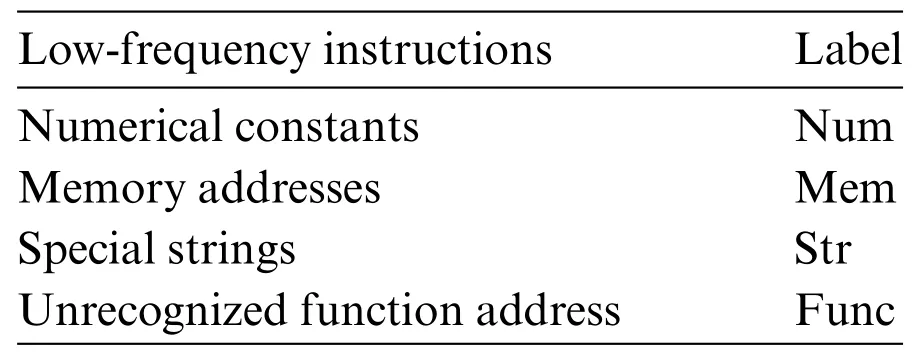
Table 1:Low-frequency instruction matching rules
1.Operators are mainly used to increase the readability of the codes,and they have little effect on the code analysis.Therefore,they can be removed and identifiers are separated by spaces.
2.Eliminate the extra overhead caused by low-frequency instructions by establishing a matching table,as shown in Table 1.
The original binary program needs to be de-obfuscated and then the CFG structure can be optimized.We convert them into VEX-IR code and clean instructions before inputting them into the code similarity evaluation network.
3.2 Code Similarity Evaluation for Multi-Layer Data Embedding
An unavoidable difficulty in binary code similarity analysis is that programs of different architectures cannot be compared directly.As the architecture changes,the format of the instruction set and binary code will also change dramatically.Therefore,simply comparing the similarity of the program syntax to evaluate the similarity of the code is not feasible.Other features of the program need to be compared.The principle of binary code similarity analysis is based on the similarity comparison between features of functions,while natural language processing (NLP) techniques can perform similarity comparisons on words in text[46].Therefore,we resort to the idea of NLP to solve the problem of binary code similarity analysis.
The basic block of programs is composed of multiple instructions,and each instruction consists of an operator and several parameters.For example,{push eax,num}is an instruction,where push is the opcode,eaxandnumare the operands.Therefore,each instruction of the program can be regarded as a word,and then the instructions are encoded into instruction vectors by distributed word encoding.We utilize skip-gram to convert instructions of the basic block into feature vectors,thus the basic block can be regarded as a sentence composed of phrases.We introduce the bidirectional long short term memory(BiLSTM)model[47,48]to add the basic block function feature vector with an additional basic block semantic information vector to form a basic block embedding vector with basic block attributes.These basic block embedding vectors represent the attributed control flow graph(ACFG).ACFG contains useful information on the basic block function and also integrates the semantic information of the context into the feature vector.As a result,our program can be employed for programs on different architectures.
After obtaining the ACFG vector of each basic block,the structure2vec network is used to convert the ACFG vector into a more complex graph,thereby obtaining a high-dimensional feature vector.The feature vector is used for code similarity evaluation.Fig.2 shows the workflow of code similarity evaluation.
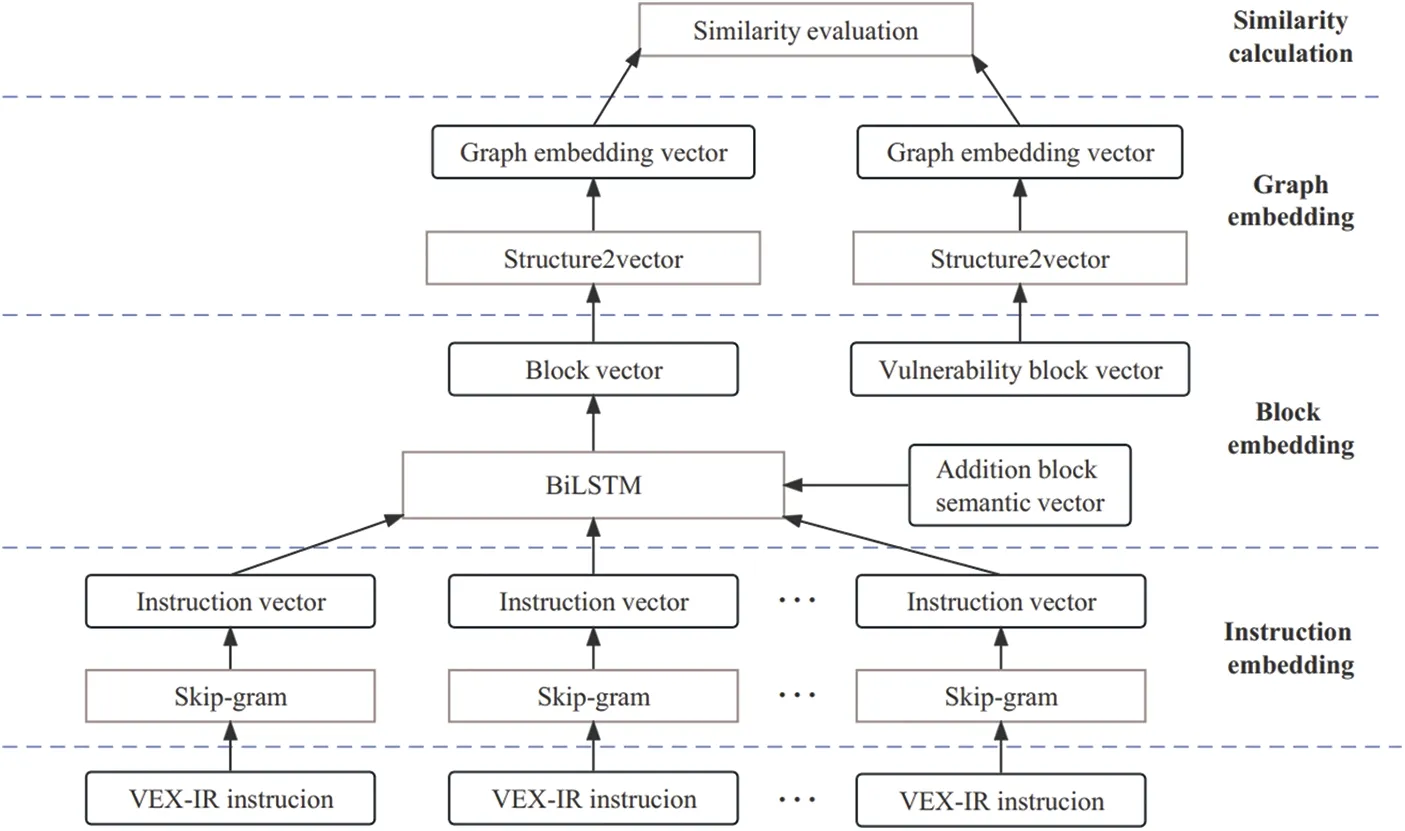
Figure 2:The framework of similarity evaluation model
3.2.1 Instruction Embedding
Skip-gram model connects the intermediate vocabulary with the entire text by controlling the size of the sliding window.However,it will increase the computational overhead and training time.The instruction embedding of programs only considers the semantic information and context of basic blocks.Therefore,we improve the model by using intermediate words to predict context and keywords,to increase the contextual connection of basic blocks and the utilization of semantic information with less training overhead.The improved skip-gram model is shown in Fig.3.
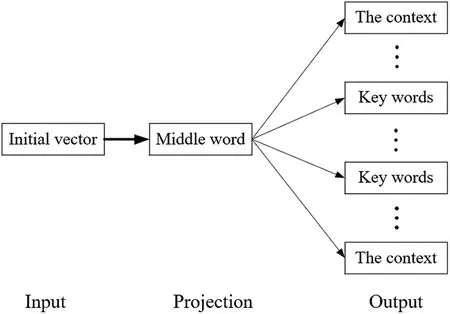
Figure 3:The framework of the skip-gram model
By constructing a sliding window of sizem,all the instructions of the basic block are mapped to a specific position,and the number of instructions in each position is 2m+1.According to the given instruction,instructions of the basic block are constructed as:
wherem+1≤i≤N-m,andNis the total number of instructions with practical significance.
The loss function of the improved skip-gram model is defined as:
The structure of the instruction embedding model based on skip-gram is shown in Fig.4.

Figure 4:Instruction embedding model based on skip-gram
3.2.2 Block Embedding
We adopt BiLSTM to extract the contextual semantic information carried by the basic block to improve the integrity of the basic block information.As shown in Fig.5,is an instruction embedding vector,which is used to construct a basic block.is inserted into the LSTMfin the correct order,and then inserted reversely into the LSTMb.The two components of LSTM,and,are fused as the basic block embedding vectorhcombgenerated by the BiLSTM model.This embedding vector contains all the useful semantic information of the basic block.
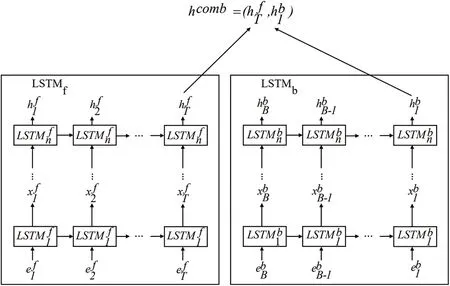
Figure 5:The workflow of the BiLSTM
To improve the overall performance of the model,we introduce a self-attention network after the BiLSTM network,which can effectively transfer information while reducing redundant embedding vectors.
3.2.3 Similarity Calculation Model
Neural networks are adopted to calculate the similarity between the functions in the program and the functions in the vulnerability library.This similarity is used to determine whether the program contains high-risk functions.We convert the binary program into an ACFG,such that each node has features related to the basic block not only the source code,but also the relationship between them can be readily obtained.
Let the ACFG be a function asg=(V,E),whereVrepresents the eigenvector of the vertices of the program basic block,andErepresents the set of eigenvectors of the calling block and the called basic block of the program.
Each basic block vertex vectorvinVhas a propertyxvidentical to the rest of the vertex vectors in ACFG.The feature vectors representing the functions of the basic blocks are generated in the pdimensional space composed of the basic blocksv(v∈V),and then the vertex feature vectors of all the basic blocks are aggregated.At last,the embedding vectorof ACFG is generated as follows:
Based on the structure2vec network,we proposed the ACFG embedding vector generation method and its basic block vertex vector mapping relationship as:
Among them,xvis a d-dimensional vector,representing the features of the ACFG nodes,W1is ad×pparameter matrix,andpis the embedding dimension of ACFG.σrepresents a fully connected network withnlayers:
wherePi(i=1,2,···,n)is ap×pparameter matrix.
The structure2vec network proposed in this work adopts recurrent neural(RNN)networks as its backbone.We use the attention network to fuse the feature vector generated by the previous network unit to further reduce the redundant part in the feature vector.The structure of the structure2vec network proposed in this paper is shown in Fig.6.We measure the similarity by calculating the cosine distance between the ACFG vector corresponding to the input binary program and the ACFG vector corresponding to the high-risk vulnerability function in the sample library.We design the structure2vec network as a twin structure and then calculate the similarity of the input vectors to obtain the similarity score.The twin architecture is shown in Fig.7.
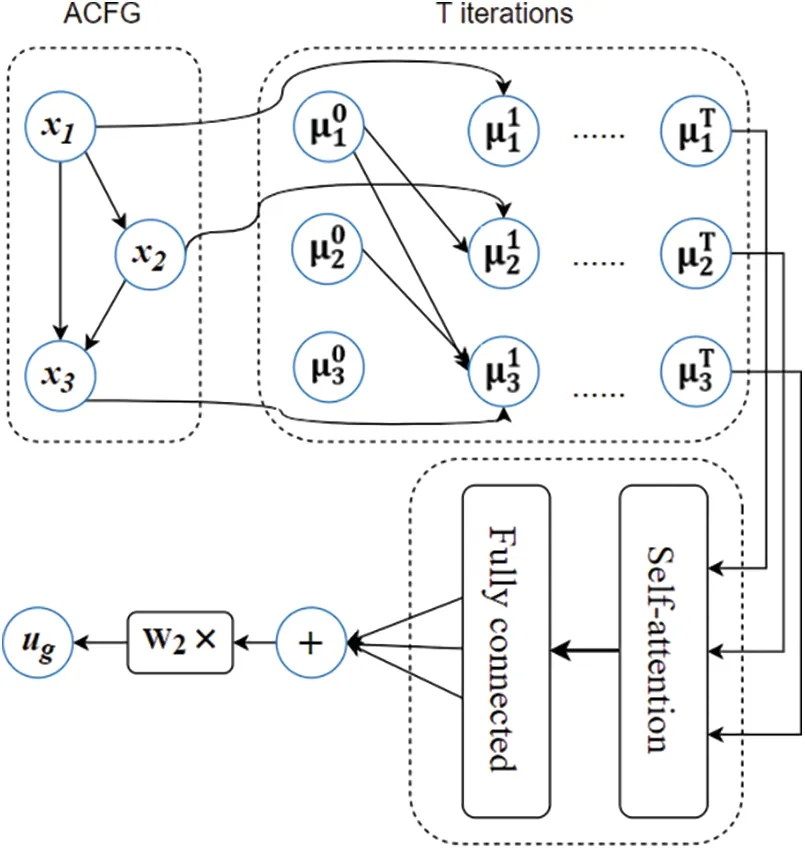
Figure 6:Structure2vec with self-attention

Figure 7:The proposed twin architecture based on the structure2vec network
The two structure2vec networks take thegandg′of ACFG as input during the training process.We obtain the graph embedding vectorsϕ(g)andϕ(g′)by the embedding algorithm.Then,the similarity between them is obtained by calculating the cosine distance:
wherenrepresents for vector dimension,andφ(g)is the vectors in ACFG.
If the similarity score is greater than or equal to the threshold,we output the function name and the address in the memory of the program.Then we use symbolic execution to solve the function,and the solution result can be converted into the initial seed of the fuzzing and input into the fuzzing system for vulnerability mining.Subsequent seed mutations will also be performed based on the generated initial seed.
The biggest challenge of symbolic execution is the path explosion issue.If the program can generate test cases with a high coverage rate under the premise of as little path exploration as possible,then the risk of path explosion can be greatly alleviated.To solve this issue,we first determine the functions in the program that may have potential vulnerabilities.We then conduct fuzzing for these functions.We proposed the simnetseed-based system to increase the speed of fuzzing by increasing the effective coverage of the path in fuzzing,and to solve the high-risk vulnerability functions detected in the program by symbolic execution.
4 Experiments
4.1 Vulnerability Database and Dataset Construction
To identify potential security risks by the similarity of binary codes,it is necessary to establish a vulnerability sample library.By consulting the common vulnerabilities and exposures(CVE)website,a large number of CVE vulnerabilities can be obtained,and we divide them into two categories according to the source of these vulnerabilities.
1.Vulnerabilities obtained from source code.We collect the relevant function source code from the internet and use the arm-gcc compiler to convert it into binary functions under the advanced reduced instruction set computer machines (ARM) and microcomputer without interlocked pipeline stages(MIPS)architectures with different compilation optimization levels.
2.Vulnerabilities in IoT devices.To detect the security of binary functions,such as the security of firmware,unpacking tools such as binwalk and interactive disassembler professional(IDA Pro)can be used to detect the security of binary functions.
We de-obfuscate and optimize the CFG structure of the binary codes,converting them into VEX-IR intermediate codes and conducting data cleaning.At last,the ACFG embedding vectors are obtained through Word2vec and BiLSTM networks,which constitute the vulnerability sample library.We constructed a vulnerability sample library with a total of 1,266 samples.
We adopt the method provided by InnerEye-BB to construct an appropriate dataset for model evaluation.Specifically,we use gcc and clang compilers and set three optimization levels of O1-O3 to compile several functions of OpenSSL(v1.0.1a and v1.0.1f)and Linux packages to obtain the dataset.Then the dataset is further divided into three parts training,validation,and testing.The details of the dataset are shown in Table 2.

Table 2:Dataset partition details
4.2 Evaluation
4.2.1 Influence of Hyper-Parameters
We train the similarity evaluation model for 10 epochs using the training set,and then use the test set to evaluate the accuracy and reliability of the model.In order to study the influence of the dimension of instruction embedding on similarity discrimination,we set the dimension of instruction embedding from{20,40,60,80,100}.The experimental results are shown in Table 3.It can be observed that increasing the number of dimensions will increase the area under curve(AUC),but the AUC is not simply determined by the dimension of instruction embedding.Therefore,we set the dimension of instruction embeddings to 60 in subsequent experiments.

Table 3:The influence of the dimension of instruction embedding
Then,we compared the AUC under different basic block embedding dimensions.As shown in Table 4,increasing the dimension will result in better performance.Considering that a higher embedding dimension will significantly increase the computational cost,we set the basic block embedding dimension to 10.

Table 4:The influence of the dimension of basic block embedding
4.2.2 Comparison with Other Methods
We compare the performance of the proposed model with InnerEyeBB [49],DeepBinDiff [50],and DeepWalk[51]on the validation set,and the experimental results are shown in Table 5.

Table 5:Comparison with other methods in feature extraction
We verify the effectiveness of the proposed similarity evaluation method by comparing it with the Genius and Gemini models.The experimental results are shown in Table 6.It can be seen that the performance of the proposed method is better than that of the Gemini model.Compared with the unsupervised learning model Genius,it has achieved a great lead.

Table 6:Comparison with other methods in similarity evaluation
4.2.3 Simnet-Seed Application Test
We integrated the method proposed in this work into the simnet-seed tool for practical application tests.The overall workflow of the simnet-seed tool for vulnerability detection is shown in Fig.8.

Figure 8:The workflow of vulnerability mining
We first use simnet-seed to load the binary program,then de-obfuscate the binary program and optimize the CFG structure to restore the real control flow graph of the program.Then we convert the program language into the intermediate language to eliminate the influence caused by different architectures and compiled languages.Similarity matching is performed between the functions in the program and the functions in the vulnerability library.Finally,the symbolic execution is performed on the similarity score and the solution is converted into the initial seed of fuzzing.We take the CVE vulnerability(Heartbleed Vulnerability,CVE-2014-0160)as the case and the libfuzzer as the fuzzing tool to verify the proposed method.It can be seen from Figs.9 and 10 that when using the seed generated by the simnet-seed tool as input,libfuzzer has covered 570 basic blocks of the program after 34,988 executions and found 34 abnormal input bytes in 512 bytes,and successfully found the asan_memcpy()function belonging to the heap overflow vulnerability.When the seeds generated by the simnet-seed tool are not used,libfuzzer has covered a total of 565 basic blocks of the program after 141,619 executions and found 53 input bytes out of 2,785 bytes before successfully finding the asan_memcpy() vulnerability.It can be seen that the seeds generated by the simnet-seed tool cover more basic blocks with fewer execution times.
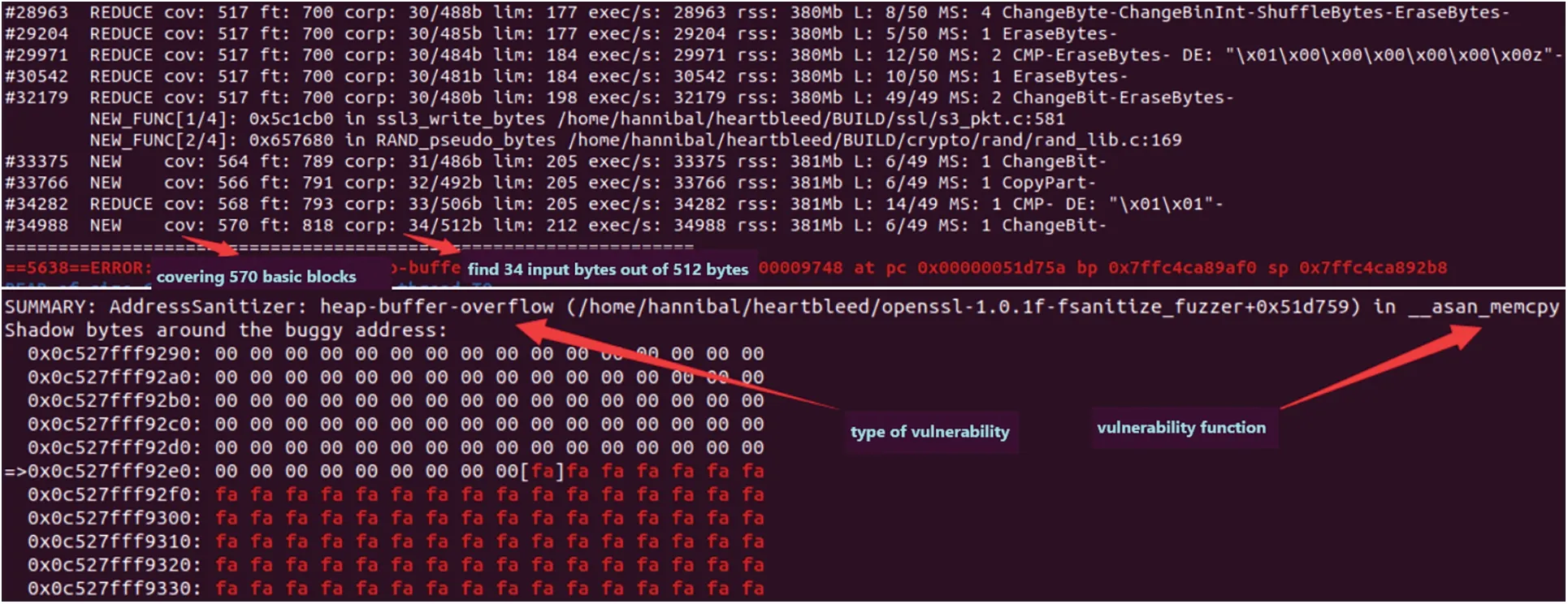
Figure 9:The output of libfuzzer with seed generated by the simnet-seed tool
Finally,we combine the simnet-seed tool with the mainstream symbolic execution tool Driller,the fuzzing tool AFL++,and the hybrid fuzzing tool qsym to verify its effectiveness.We adopt five programs named Xpdf,TCPdump,Adobe Reader,Gimp,and Libxml2 as test samples,respectively,and record the time it takes to generate the first three crashes.The experimental results are shown in Table 7.

Table 7:Time-consuming comparison of generating crashes with and without simnet-seed
It can be seen from Table 7 that when these three fuzzing tools are combined with the simnet-seed tool,the time-consuming to generate the first three crashes is significantly reduced,i.e.,the effective coverage of the seeds generated by simnet-seed on these five programs is better than the seed generation and mutation strategies of the fuzzing tool.This also proves that the path exploration algorithm with dynamic seed priority and threat function priority can effectively improve the overall path exploration ability of fuzzing.We believe that the simnet-seed tool can significantly improve the mining efficiency of most programs,and its basic block function coverage is also beyond baselines,thus proving its reliability and effectiveness.
5 Conclusion
Aiming at the obfuscation problem of the program,we introduce and implement a de-obfuscation method,which can eliminate the influence of control flow flattening,and solve the problem of incomplete recovery results and redundant control flow graph in the obfuscation method of control flow flattening.Aiming at the problem of cross-architecture cross-compiler and compilation options,this paper introduces and implements an interlingua transformation method based on VEX-IR.By using label replacement to realize VEX-IR preprocessing,the learning efficiency of basic blocks based on interlingua is improved.We proposed a basic block embedding method based on bidirectional LSTM,which solves the problem of missing important information such as semantics when embedding basic blocks.Aiming at the measurement problem of binary code similarity,we proposed a binary function similarity analysis method based on graph embedding.Before the ACFG embedding vector is finally generated,the self-attention mechanism is introduced to improve the quality of the feature vector,and the important features of the basic block are integrated to solve the error of manual feature construction and the problem of semantic loss in function similarity analysis.We proposed a seed generation method based on function similarity detection,which solves the problem of symbolic execution path explosion and also meets the high coverage requirements of fuzzing for test cases.In the experiment,we used the simnet-seed tool for vulnerability mining and detection and verified the effectiveness of the proposed method in vulnerability detection and fuzzing speed optimization.
We built a professional analysis tool that security researchers can use to achieve cross-architecture analysis of source-free binaries.By generating more effective test cases and optimizing test objectives,the tool makes fuzzing more efficient,accelerates the discovery of potential vulnerabilities,and improves the efficiency of testing.Through the identification and analysis of key functions,the research is helpful to dig into the possible security risks in the software,improve the depth and breadth of safety analysis,and enhance the safety analysis.The cross-architecture analysis technology of the research increases the generality of the method,makes it applicable to various software systems with different architectures,and improves the flexibility of the research in practical applications.The research enhances the feasibility of fuzzing testing tools in large-scale projects,provides a set of innovative and practical methods for the field of software security,provides strong support for the improvement and performance enhancement of fuzzing testing tools,and provides a more reliable solution for practical applications.
Our proposed technique can mitigate the risk of path explosion without obtaining the source code,and protect the privacy and security of users to a certain extent.
Admittedly,our work has achieved good effectiveness,but there are still some limitations in the implementation process.This article is based on the VEX-IR intermediate language,but the basic block embedding vector generation involves modifying the LLVM backend to add ID to the basic block and then converting it to VEX-IR.This would be slower but complete,so consider changing the intermediate language type unification to LLVM-IR.
In the future,we plan to optimize the structure2vec model to build an n-layer fully connected neural network to improve the efficiency of message functions.In addition,we also consider using gated recurrent unit(GRU)networks to replace the original RNN networks,hoping to alleviate the problems of long-term memory and gradient disappearance more effectively.
Acknowledgement:Not applicable.
Funding Statement:The authors received no specific funding for this study.
Author Contributions:The authors confirm contribution to the paper as follows:study conception and design:Zhenhui Li,Shuangping Xing;data collection:Lin Yu,Huiping Li;analysis and interpretation of results:Fan Zhou,Guangqiang Yin,Xikai Tang;draft manuscript preparation:Zhiguo Wang.All authors reviewed the results and approved the final version of the manuscript.
Availability of Data and Materials:Not applicable.
Conflicts of Interest:The authors declare that they have no conflicts of interest to report regarding the present study.
杂志排行
Computers Materials&Continua的其它文章
- MDCN:Modified Dense Convolution Network Based Disease Classification in Mango Leaves
- Advanced Optimized Anomaly Detection System for IoT Cyberattacks Using Artificial Intelligence
- Artificial Immune Detection for Network Intrusion Data Based on Quantitative Matching Method
- An Improved Harris Hawk Optimization Algorithm for Flexible Job Shop Scheduling Problem
- Adaptive Segmentation for Unconstrained Iris Recognition
- Enhancing Multicriteria-Based Recommendations by Alleviating Scalability and Sparsity Issues Using Collaborative Denoising Autoencoder
